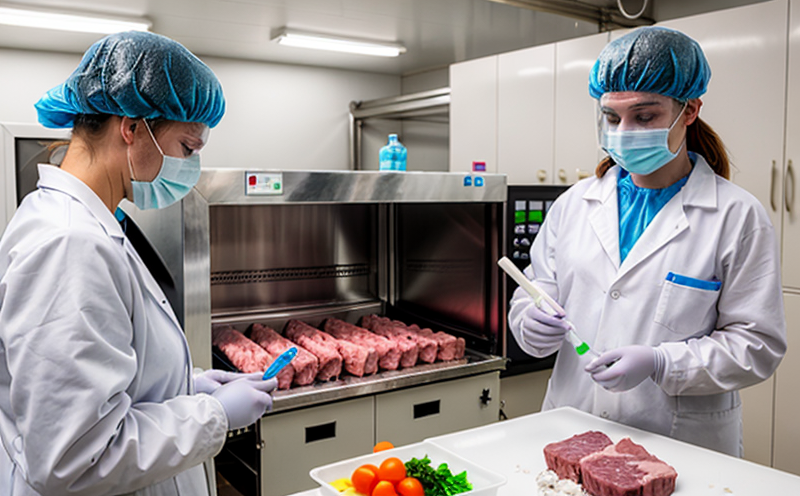ISO 11290-1 Listeria monocytogenes Detection Testing in Dairy
The presence of Listeria monocytogenes in dairy products poses significant risks to public health. This bacterium can cause a severe infection known as listeriosis, which is particularly dangerous for pregnant women, newborns, the elderly, and those with weakened immune systems. The ISO 11290-1 standard provides a robust framework for detecting Listeria monocytogenes in dairy products through microbiological testing.
The process begins with proper specimen collection from various points within the dairy production chain—raw milk, cream, yogurt, and cheese. Specimen preparation involves homogenization to ensure even distribution of cells throughout the sample. Following homogenization, selective enrichment broth is used to enhance the growth of Listeria monocytogenes while suppressing other microorganisms.
The next step is isolation and identification using selective culture media such as TECBS (Trypticase Soy Broth with 0.5% L-cystine, 2% glucose, 100 μg/ml thymidine) or MYPAG (MRS broth with 1% yeast extract, 0.4% mannitol, 3% polyvinyl alcohol). These media are designed to support the growth of Listeria species while inhibiting other bacteria.
Once isolated colonies suspected to be Listeria monocytogenes have been identified, they undergo further identification using biochemical tests like the Gram stain, catalase test, and the utilization of mannitol. Confirmation is achieved through serological methods or molecular techniques such as PCR (Polymerase Chain Reaction), which are highly sensitive and specific.
The use of ISO 11290-1 ensures a standardized approach to detecting Listeria monocytogenes in dairy products, enhancing the accuracy and reliability of test results. This standard is widely recognized by regulatory bodies around the world, including the European Union, United States Food and Drug Administration (FDA), and World Health Organization (WHO).
The importance of this testing cannot be overstated. Contamination with Listeria monocytogenes can lead to recalls, financial losses, and potential legal actions. By adhering to ISO 11290-1, dairy producers ensure compliance with international standards, thereby protecting consumer health and maintaining a positive brand reputation.
The testing process is not only critical for quality assurance but also plays a vital role in regulatory compliance. Regulatory authorities require that all dairy products are free from Listeria monocytogenes. The use of this standard ensures that the testing meets these stringent requirements, providing peace of mind to both producers and consumers.
Accurate detection is achieved through rigorous laboratory practices, including strict adherence to ISO 11290-1 guidelines. This includes the use of certified reference materials (CRMs) for calibration purposes and regular quality control checks to ensure consistent and reliable results.
In conclusion, the implementation of ISO 11290-1 in dairy microbiology testing is essential for ensuring food safety and compliance with international standards. By detecting Listeria monocytogenes early, dairy producers can prevent contamination and uphold the highest standards of quality and safety.
- International acceptance
- Regulatory compliance
- Consumer trust
- Brand protection
Why It Matters
The detection of Listeria monocytogenes in dairy products is crucial for several reasons. Firstly, it directly impacts public health by preventing the spread of listeriosis. Listeriosis can lead to severe illness and even death, especially among vulnerable populations.
Dairy producers are under constant pressure to ensure their products meet strict quality standards. By implementing ISO 11290-1, they demonstrate their commitment to food safety and consumer protection. This standard provides a clear framework for testing that is recognized worldwide, ensuring consistency in results across different laboratories.
Compliance with international standards not only helps producers avoid legal issues but also enhances their reputation. Customers are increasingly demanding transparency and reliability from the brands they choose. By adhering to ISO 11290-1, dairy companies can build trust with their customers and stakeholders.
The importance of this testing extends beyond individual producers; it plays a role in protecting public health at large. By ensuring that dairy products are free from Listeria monocytogenes, the entire food industry contributes to safer consumption practices.
In summary, ISO 11290-1 is essential for maintaining high standards of quality and safety in dairy microbiology testing. It ensures that producers meet regulatory requirements, protect public health, enhance brand reputation, and build consumer trust.
Benefits
The implementation of ISO 11290-1 offers numerous benefits to dairy producers and the broader food industry:
- Enhanced Food Safety: By detecting Listeria monocytogenes early, producers can prevent contamination, ensuring that their products are safe for consumption.
- Regulatory Compliance: Adherence to international standards guarantees compliance with regulatory requirements, avoiding legal and financial penalties.
- Improved Reputation: Demonstrating commitment to food safety through ISO 11290-1 enhances the reputation of dairy producers, building trust with consumers and stakeholders.
- Consumer Confidence: Ensuring that products meet strict quality standards reassures customers about the safety and reliability of their purchases.
- Competitive Advantage: By maintaining high standards of food safety, producers can differentiate themselves in a competitive market, attracting more customers and increasing sales.
- Sustained Operations: Avoiding recalls and legal actions due to contamination ensures the sustainability of dairy operations.
In summary, ISO 11290-1 is not just a technical standard; it is a strategic tool that supports sustainable growth and success in the dairy industry. By prioritizing food safety through this testing process, producers can safeguard public health, enhance brand reputation, and ensure long-term operational stability.





